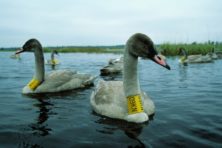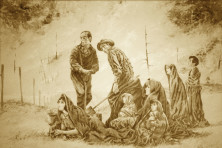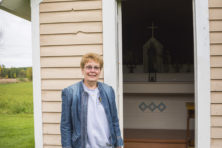The Peshtigo Fire – A Natural Disaster in NE Wisconsin
- Share
- Tweet
- Pin
- Share
It is tempting, amid all the natural calamities that have occurred globally in recent years, to believe that something has altered in the world. Yes, global warming is real and, yes, global warming is a significant threat the world community must address. But natural disasters have been with us throughout history. Indeed, one of America’s worst natural disasters occurred right here, in northeast Wisconsin.
Those of us who live here in the northeast corner of the state have, at the very least, heard of the Peshtigo Fire, the “deadliest fire in American history.” Some of us have heard of the fire from friends, some of us have stopped at the park/wayside in Southern Door County and read the historical marker which details the destruction the fire caused on our own peninsula, and some of us may have read Father Peter Pernin’s eyewitness account of the fire and its aftermath.
Whether you know something of the fire or not, a book entitled Firestorm at Peshtigo by Denise Gess and William Lutz, published by Henry Holt and Company, provides a complete history of the fire. The book begins weeks before the horrific events on the night of October 8, 1871, carefully detailing the range of fires that were burning throughout the Upper Midwest and the circumstances of the drought conditions that existed, and shows how human activity (in the form of the timber industry and railroad construction) and nature (the towering, densely-packed white pine forests and the cataclysmic weather conditions) combined to create one of our country’s greatest natural disasters.
Drawing on newspaper records, government papers, journals, personal correspondence, transcripts of interviews with survivors, and more, Gess and Lutz tell a story filled with images that continue to haunt long after you have finished the book. They also add fascinating detail to stories we thought we knew.
As an example, the Great Chicago Fire, which occurred on the same night as the Peshtigo Fire, is known by almost everyone – at least in the Midwest. But did you know that the Chicago Fire Department responded to 29 major fires in the week preceding the Great Chicago Fire? And did you know that on October 7, 1871 – the day preceding the Great Fire – the Chicago Fire Department, utilizing every piece of equipment available to them, spent 18 hours battling a factory fire that leveled a six block area on the near west side?
Those who survived the Peshtigo Fire (and there were less than 200 of the estimated 2,000 who resided in the city at the time) had a common refrain when asked to describe their experience: “words fail.” To the credit of Gess and Lutz, when it comes time to describe the fire and the nature of a firestorm, their words become almost poetry.
Here is Gess and Lutz’s description of the cataclysm that destroyed Peshtigo, the Sugar Bushes, Williamsonville (in Southern Door), portions of other communities, and countless outlying farms:
“The Peshtigo fire was the ultimate mixed metaphor: a flamethrower, a monster, a giant, a fiend, a tempest arriving on waves, wings, columns, and plumes and always more beautiful than, faster than, hotter than the mind can fathom. A firestorm. Nothing compares to the extreme violence of a firestorm, and no other fire exhibits more unpredictable and outrageous behavior during which superheated flames of at lest 2000 degrees Fahrenheit (the temperature of a crematorium) advance on winds of 110 miles per hour or stronger. The diameter of such a fire ranges from one thousand feet to ten thousand feet – three to thirty-three football fields wide. When a firestorm erupts in a forest, it is a blowup, nature’s nuclear explosion, generating the same heat and devastating power as an atomic bomb. The only precedent for a fire of such magnitude, the only frame of reference for a firestorm, was the Great Fire of London in 1666.
“Most fires are containable, controllable; few ever reach dangerous proportions. In a firestorm, size is not as important as intensity, unpredictability, and the kaleidoscopic effects produced from such extremes of heat and movement. A firestorm’s operatic voice displays incredible range, from the barely audible soft crackle to the roar. Its choreography is multipatterned; it slinks, streams, shoots, vibrates, marches, pitches, bursts, stalks, rolls forward, upward, backward, and in circles. Because it is blind and deaf it cannot be trusted to make distinctions, will not see or hear the pain of children, the cries of women, the shouts of men. A firestorm knows no empathy, only hunger – and never thirst. Wind is the invisible bully at its back, whipping the flames into a frenzy of lusty gorging. It must eat and cannot get enough and the more food it consumes the hotter and more passionate it becomes. It cannot contain itself and blows its volatile, noxious breath sky-high in whirring convection columns as the cold air rushes in at its feet, pumping its overheated, bloated belly full of hot air upward. Sand will feed it, bark, kerosene, hay, sawdust, clothes, coal, leaves, wooden buildings, trees, flesh. Anything combustible will do. Staying alive is all that matters to a firestorm.”
As powerful and poetic as the descriptions of the fire are, the truly haunting portions are in the stories of the individuals who faced this behemoth. Those that remained alive after the firestorm had passed were dehydrated, most suffered some type of blindness, most had serious burns, and most had respiratory problems (many that perished died before they were actually burned by the fire as a result of inhaling the superheated air, which seared their lungs causing their chests to collapse). I’ll end this with one section of one of these stories, in this case, the story of Thomas Williamson, of Williamsonville. On the morning of the October 9, Williamson and the small group of survivors he has fallen in with are preparing to set off to Little Sturgeon Bay.
“Before they left, Thomas walked around the burned out area, looking at the bodies, trying to find anyone he knew…He went from body to body until he came to the potato patch. There he found thirty-five bodies all huddled together in an area no more then fifteen square feet.
“None of the bodies was recognizable. Later, searchers would identify the bodies through pieces of clothing and other artifacts. The bodies of the men were on the outside of the circle, in an attempt to protect the women. The body of the blacksmith lay next to the huddled group, a little way from it. He was holding a piece of burnt shawl over the face of his little girl. Next to him lay his wife with their other two children nestled close to her as she tried to protect them.”



